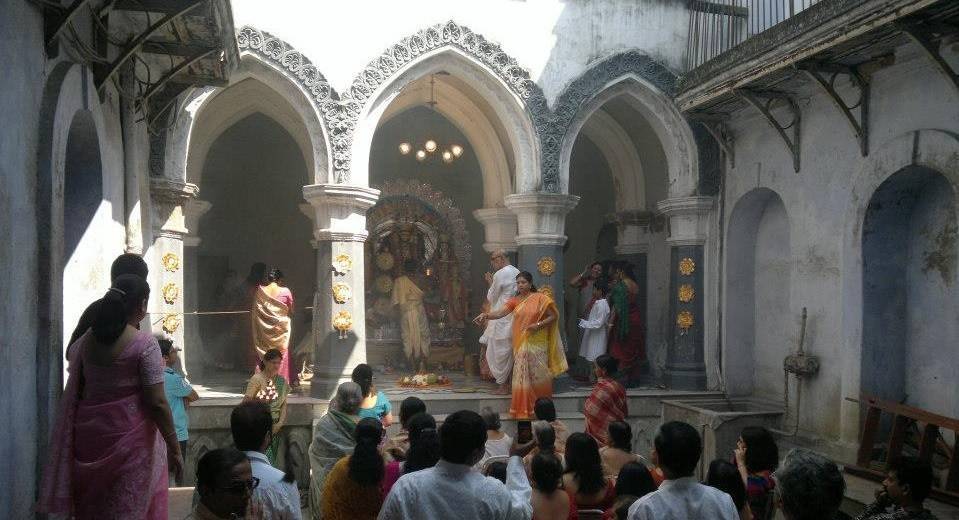Durga Puja at the Great Houses of Calcutta – A tour in tradition
by Ankan Dhar
Ankan Dhar recounts his experience, this year, avoiding the rush and noise of Pandal hopping, and checking out House Pujas (also known as ‘Bonedi’ Barir pujas, Pujas of ‘The Great Houses’) of Calcutta.
Mitra Barir Puja, Bhowanipore
The first stop on my tour of ‘Bonedi’ House Pujas is at 13, Paddapukur Road, Bhowanipore (Bhabanipor), Calcutta.
Situated between endless tea stalls, shabby buildings full of corporate hoardings , and countless food joints is the most acclaimed Mitra Bari. The determination and endless efforts of the residents marked a successful completion of 116 years of this house hold celebration. ‘
Kalidas Mitra is regarded as founder of the Mitra dynasty. Known to be religious and humble in nature, he inaugurated the Mitra Bari Durga Puja in 1757 AD. It is at Padapukur in the year of 1892 that the late Subodh Chandra Mitra of 26th generation infused the festival with its highest splendor and magnificence. And now in the 28th century the lineage is carried forward by Mr. Sukhomoy Mitra and his cousins.
The built in frame of the Devi is made by the artisans who travel from Kumartuli to reside in Mitra bari premises for days . After the successful completion of deity, she is ornamented with various weapons, instrument and gold which the family preserved for years. Maha Panchami inaugurates the Puja with a lamp being lit which continues to burn till Maha Dashami. The bodhon (salutations) of the supreme is held at thakur ghar which permits the access of the on-lookers and deity prayers. Being Non-Bramhin the family doesn’t serve Annabhog ( Rice) instead they offer a preparation which comprises of Luchi, Vegetables, Ghee, Curd and sweets ,which is termed as Sital, during Puja
With the dawn of Maha Saptami the individual on who’s name the Puja will be conducted, sanction the Purohit (priest)to perform the worship on his behalf and as a process of which the very person need to fast till MahaAstami unless the Bhog is offered to the deity which will only be considered as his Prasad(meal) . Nowadays, it is by the name of Subrit and Suprit Mitra both subsequent members of the 30th generation on whom the Sankalpa is conducted.
On Saptami the Kolabou (or Nabapatrika of which nine plants including prominently, Banana Plant (Kola Gaach), which was not originally part of Durga Puja but integrated into the ritual) is bathed on the premises itself, as she embodies the the daughter –in – law of Mitra Bari, who can’t go outside for bathing during rituals. The fine ingredients and perfumes used in this process are collected from all over the country. After completion of this procedure the kalabou is positioned next to Lord Ganesha. Sandhi Puja is a must for the family tradition which is performed between the transition period of Astami & Navami . Her adornment consist of bangles, sari, perfumes utensils, bedding.
In Maha Dashami as per the traditional approach of Mitra Bari, an earthen vessel is organized filled with water and turmeric, which enables the visual of the goddess from head to toe, while the priest chant the immersion mantra it is to be considered that the immersion is on process. (Use of reflection is common in the bathing ritual of Durga Puja but use of water, is symbolic of immersion.) Finally in the evening of Maha Dasami the idol is carried to the Ganga river for final immersion and the frame is carried back by the women of a family for the future years.
‘No matter wherever we are, we tend to gather around here for the festival,‘ said Sukhomoy Mitra introducing himself as one of the scions of the dynasty . The astounding Durga Idol was placed a few yards inside the main gate to secure a proper view of the onlookers.
‘ No household pujas around the city , ever positioned the idol like we do,’ declared by a senior member of a family who was playing the drum sticks, proudly
‘ it is the cause of the swarm of uncontrollable spectators back in my school days that we preferred this placement of the deity .those people were highly informative about the nuances of this ritual, ‘Mr. Sukhomoy Mitra reminisced.
Another significant feature of the idol is the prominent visibility of her 2 hands instead of ten, where the rest 8 hands are highly secluded behind her thick long hair. It was an incident years back when the Mitra bari authority decided to perform the ritual with its upmost grandeur, but during the process they had to forcefully conclude the arrangement of jewelry for her two hands instead of ten due to an economic circumstance. Devi consoled the then organizer in his dream and mandated him to limit the matter with two hands only and since then the Idol is considered as DuBhuja instead of Dasabhuja.
The alluring five days experience of Mitra Baris’ dazzling extravaganza will surely leave a delightful experience for the Durpa Puja enthusiasts
 The Global Calcuttan Magazine
The Global Calcuttan Magazine 